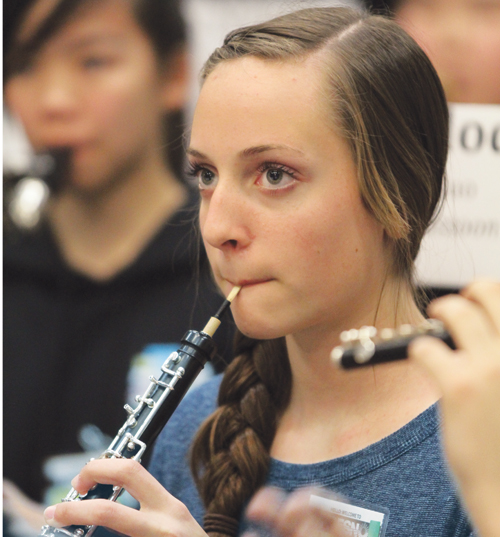
The oboe has undergone many improvements and advances in its key work and construction over the years, but it remains an imperfect instrument. Of the few remaining quirks instrument makers have yet to solve, a universal F fingering likely tops the list. Oboists have two alternate fingerings in addition to the regular F. To successfully navigate their way through any given piece, oboists must determine which of the three fingerings offers the most ease of use each time the note appears.
The regular (or right-hand) F refers to the narrow key on the bottom joint between the E and D keys; it is played with the right ring finger. Technical facility with this fingering is quite good, provided the notes immediately preceding or following the F do not use the D key, which is also played with the ring finger. Direct movement between the two feels clumsy and sounds awkward.
Beginning oboists encounter this stumbling block from the very start; the Eb fingering (which is introduced early on in most band books) includes the D key, and to play the Bb scale successfully, students must abandon the regular F for another option. This leads to students learning an alternate fingering before they learn the regular fingering; suddenly the alternate becomes the default.
In lieu of the regular F, the next logical choice would be the left-hand F, a pinky key located just above the cluster of keys on the left side of the instrument. This key vents the same tone hole as the regular F, and the two are interchangeable in terms of both tone and pitch. It also frees up the ring finger, which enables smooth passage between the Eb and left F fingerings.
Unfortunately, this key is unavailable on most student-model oboes. When students upgrade to a more professional instrument, they often complain that the fingering feels unnatural and are reluctant to use the left-hand F. It takes a great deal of isolated practice moving from Eb to the left F fingering before an oboist will feel comfortable using it in a technical passage.
Without the left-hand F key, students have little choice but to use the second alternate fingering, the forked F. This alternate gets its name because it uses the first and third (but not the second) fingers on the right hand. This fingering is considered an alternate because the tone is a bit stuffier than the regular F option.
To complicate matters further, most student oboes lack an F resonance key, which helps to stabilize the pitch and improve the tone of the forked F. Many beginning band books go so far as to include the Eb key in the forked F fingering; the Eb tone hole is located in roughly the same location on the bottom joint as the F resonance. While adding this key to the forked F on a student oboe does improve pitch somewhat, it becomes necessary (albeit nearly impossible) to break students of this habit when they move to an intermediate or professional instrument that is equipped with the resonance key. Venting both keys simultaneously raises the pitch of the F a quarter step.
The best way to teach students the importance of using all available F fingerings is to address the need for alternate fingerings from the start. When beginning a new piece, assign oboists the extra task of selecting a fingering for each F in their part. They can mark their choice by writing R, L, or F (for regular, left, or forked, respectively) above the note. If teachers repeat this request with each new piece, young oboists will soon learn to use all the fingering options at their disposal.






